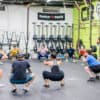In the strength and conditioning field there are several “principles” that have been advocated throughout years. One of them is the “Principle of Reversibility”. This simply states that when you stop training you lose the physiological improvements of training you have made over time (Green, 2017). For example if you were specifically on a back squat cycle and you squatted every day, hit the PR you wanted, then stopped squatting every day, over time it would be hard to hit that same number or further more be able to PR past that weight.
Now, this principle becomes an issue in our sport specific training for our youth athletes ONLY when we are not clear on two things. We need to know specifically what we are trying to improve in our athletes and how much time we have to train these athletes.
When it comes to strength and conditioning at the middle and high school level, as we discussed in parts 1 and 2, we rarely train a kid year round. Most youth athletes and especially teams will see us for two 6-8 week sessions a year. This is not by our choice, but the nature of busy lives of kids. Most kids nowadays train year round in a sport on multiple teams or leagues. I’m here to say that 6 weeks is still an ample amount of time to achieve sport specific improvements that translate on the field! Not only is it enough time, but a structured strength program can dramatically improve athletic ability and prevent injury in sport.
Let me say that again, despite the principle of reversibility, there is still significant changes that we can improve upon to make a youth athlete better on the field in just 6 weeks. We simply need to be clear about what this program is actually improving in terms of athletic ability. Here is a general list of what most coaches and parents want to see: improved agility, speed, strength, accuracy, less ground contact time, less injury etc. If we grouped the general physical skills of athleticism together we would find that some improve based on practice while some improve based on training. Training implies organic change in the body, increased muscular size or change in muscular fiber type distribution. Practice implies nervous change, because I am more experienced at this skill I am better aware of how to use it (CrossFit, 2018). Where most people go wrong is proclaiming the benefits of training, changing muscular tissue, versus practice, training nervous tissue. In 6 weeks, based on the principle of reversibility, my training improvements will most likely decrease; however, my improvements based in practice will increase!
So what skills lead to improvement when practice is involved? Let’s go back to what those coaches wanted to see: increased agility, speed, accuracy, ground contact time, and yes even strength. In a 6 week strength and conditioning program an athlete can expect to become better cognitively aware of movement patterns and by default more athletically coordinated. This in turn translates to improving the qualities most likely to increase sport specific athleticism, those listed above. These skills take practice, an educated professional to teach and just a short amount of time to improve. The payoff in sport is immense.
Author Daniel J. Green Contributor Daniel J. Green is ACE’s Senior Project Manager and Editor for Publications and Content Development. In addition to his work with organizations including the International Association of Fire Fighters and Agriculture Future of America. (n.d.). Certified™: March 2017 – Reversing Reversibility: How to Help Clients Get Back on Track. Retrieved from https://www.acefitness.org/education-and-resources/professional/certified/march-2017/6268/reversing-reversibility-how-to-help-clients-get-back-on-track
- (2018). What is fitness pt 1. Retrieved January 2, 2019, from http://library.crossfit.com/free/pdf/CFJ_English_Level1_TrainingGuide.pdf pp17-18





